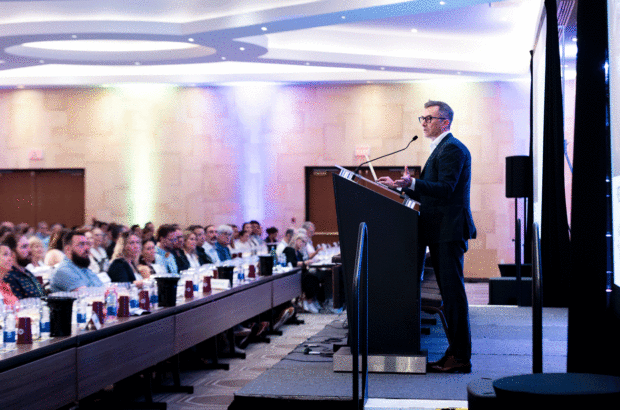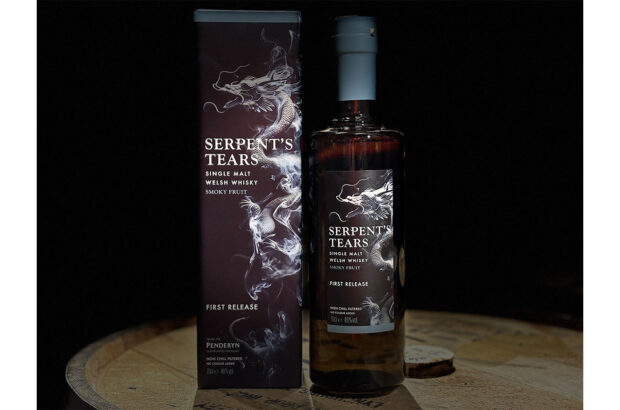STEVEN SPURRIER had met Piero and Lodovico Antinori many times, but always one brother at a time. With the pair working on their first joint venture, it was time to see what the 26th generation of Tuscany’s most famous wine family had to say about wine, and each other
Steven Spurrier had met Piero and Lodovico Antinori many times, but always one brother at a time. With the pair working on their first joint venture, it was time to see what the 26th generation of Tuscany’s most famous wine family had to say about wine, and each other…
The project
One of the reasons we decided to get together on this,’ says Piero Antinori, ‘was that Lodovico’s approach changed. At Ornellaia, he was trying to prove something, ego in the best sense; now he is trying to build something solid which will have a long continuity.
That has always been my approach and it made it easier to get together commercially after so long.’
‘This’ is Tenuta di Biserno, an estate previously devoted to forestry, on the hillsides across the valley from Bolgheri, discovered by Piero’s brother Lodovico in 1995.
Initially, he thought of incorporating the land into his Ornellaia, but, given its size and different geological character, he realised that it required a separate project. After selling Ornellaia in early 2002, he approached Piero about a joint venture.
After decades working separately, the brothers were back together. Piero is at pains to stress that ‘the soul of the wines’ is that of Lodovico.
Whoever or wherever it comes from, the wines, even from four- and five year-old vines, are a revelation. Around 90ha (hectares) are planted to Merlot (24ha); Cabernet Sauvignon (23ha); Cabernet Franc (19ha); Petit Verdot (12ha); and Syrah (12ha).
Cabernet Franc has shown particularly well, while part of the estate has stony, Rhône-like vineyards perfectly suited to Syrah. A barrel tasting of 2007s, an excellent year in Tuscany, showed them all performing well, especially the Petit Verdot, a deep, plummy, succulent yet masculine wine at a mere 12% alcohol.
Perhaps some of the elegance is due to Lodovico’s winemaker, Swedish Helena Lindberg, who admits to being very nervous when consultant Michel Rolland appears, but whose interpretation of the emerging vineyard style is admirable.
For now, two wines are sold in Europe: Insoglio del Cinghiale with 35% Syrah, and Il Pino di Biserno with only Bordeaux grapes. This is the ‘second’ wine, retailing for £35, while the first wine, code named Alpha 2, has yet to be produced.
The brothers’ aim is to create a micro wine region next door to the already established Bolgheri. The wines will remain firmly IGT, which means they are not obliged to use local varietals.
While Alpha 2 remains a work in progress, the label of Il Pino shows a coat of arms with two small boars above the Latin motto In Tempore Uniti. ‘This means “In Time, Unison”,’ says Piero, ‘and you can see that the two pigs have got together.’
It wasn’t always thus…
The popular image of Piero as the serious one and Ludovico as the playboy is unfair to both of them
The separation
Piero negotiated a buy-back of the family company between 1989 and 1991 and, once sole owner, made an offer for Prunotto, the Piedmontese producer that he and Whitbread had bought together a few years previously.
The sale was tough, but Lodovico claims it was ‘a good experience for Piero. From then, he realised that, in a company, you have to have control.’ A decade previously, Lodovico had begun planting on the 135ha estate in Bolgheri inherited from his mother.
While in America, he had considered California, but in 1981, he persuaded consultant André Tchelistcheff to come to the Maremma to offer advice. It was immediate: ‘forget about California, this is El Dorado’.
The marl and sand, schist and clay soils, and the cooler maritime climate were perfect for Bordeaux grape varieties. Emile Peynaud was called in to comment on ‘Bolgheri Bordeaux’ (the only previous example being Sassicaia), and remarked that ‘tradition is merely an experiment that has succeeded’.
The project was leant vigour by the hiring, in 1991, of Michel Rolland, who continues to work with the brothers at Biserno, and of the late Tibor Gal, the great Hungarian winemaker, and Danny Schuster, the New Zealand viticulturalist.
Results were achieved with the 1995 vintage, the reputations of both Ornellaia and Masetto going immediately into the history books. In the meantime, Piero had created Solaia from a small part of the Tignanello vineyard, a new benchmark for Chianti IGTs.
The history
Piero is the older, born in 1938, and has three daughters – Albiera, Allegra and Alessia – all active in the Marchese Antinori SPA company. Lodovico was born in 1943 and has a daughter, Sophia, born in 1999, the same year as her cousin Allegra’s eldest son.
Piero was brought into the company in 1961 and was given full responsibility in 1966, when his father Niccolo retired. Since then, the company has grown impressively, most recently via an involvement in the takeover of Napa’s Stag’s Leap Wine Cellars. Piero, who shows no signs of retiring at a very youthful 70, is the epitome of modern Italian wine, constantly innovating, firmly rooted in lessons from the past.
Lodovico spent a couple of terms at Cambridge in 1963 (possibly as much for the racing at nearby Newmarket as for the instruction, his uncle Mario Incisa della Rocchetta’s having owned Ribot, the most famous racehorse of the era) and, from 1966 to 1970, he worked for the Antinori importer Julius Wile in New York.
His main job was to sell the straw-covered Chianti fiaschi that were later turned into lamps. He realised that ‘the Antinori name meant nothing – Italy needed something to make it stand out – it was time to create a new wine.’
Piero persuaded their uncle to allow the 1968 vintage of 100% Cabernet Sauvignon Sassicaia to be commercialised, followed by the creation of Tignanello, Chianti’s first vino da tavola, in 1971.
After New York, Lodovico went to Milan to form ILA, creating one of the most dynamic Italian drinks companies, before selling it in 1978. Determined to make his own wines, he asked his brother to be bought out of the family company.
Their sister, Ilaria, also wanted out, obliging Pieroto strike a deal with Whitbread, which purchased 49%. From that moment until now, the brothers’ vinous paths diverged.
‘One reason we got together was that Ludovico’s approach changed. He was trying to prove something; now he’s trying to build something’ Piero Antinori
The reconciliation
I asked the brothers whether their rivalry had caused problems. Piero replied: ‘Overall, it was positive, in that Lodovico wanted to prove that he could make a world-class wine and I wanted to prove that Marchese Antinori SPA was second to none. Our salesmen felt the rivalry and encouraged it.’
Lodovico added: ‘If there was rivalry, it was more with Sassicaia, for the presence of Ornellaia really cemented the reputation of Bolgheri as a great terroir, which led directly to the creation of its own DOC – one of the smallest and most prestigious in Italy.’
The popular image of Piero as the serious one and Lodovico as the playboy is unfair to them both. They are both innovators in the best sense of the word, with a deep friendship but also an innate sense of rivalry.
If I had to describe each of them in two words, Piero is an empire builder, Lodovico a creative artist. That the older Piero had the responsibility of the family company passed to him, leaving Lodovico free to branch off on his own, I can, as a younger son myself, totally understand.
I have the highest admiration for – and slight envy of – my elder brother when I dine with him beneath the family portraits in Derbyshire. As Masters of the Horse (Spurrier means ‘spur-maker’) to Mary Queen of Scots, we lost our position when Elizabeth I had the former incarcerated in Tutberry Castle in 1557. Since then, the family seat has been at nearby Marston-on-Dove, always inherited by the eldest son.
From an early age, I knew this was not for me, and that I was not cut out for it. So it was with Lodovico. His attempts to make Sauvignon Blanc at Ornellaia were successful taste-wise, but not commercially, so he went to the other side of the world to prove that he could do it properly.
There he owns Mount Nelson in Marlborough, which produces a New Zealand Sauvignon Blanc from which all the habitual Sauvignon aggressiveness has been eliminated, retaining a crisp, floral elegance.
He replied to Piero’s comments that ‘the average price is low, so it is not easy to make a profit,’ by asking Helena Lindberg to create Ram’s Hill, a barrel-fermented, barrel-aged wine aged for an extra nine months in bottle, and a truly complex Sauvignon (as it should be at £26). He also makes, when the vintage allows, the 6 puttonyos Tokaji, Baron Bornemisza.
I asked the brothers which of all their wines they were most happy with. Both opted to separate their emotional satisfaction from the classic successes. For Piero, the former was Chianti Classico Villa Antinori 1967, the first wine he ever had complete control over.
This wine (a very good vintage) was opened in 2006 to celebrate his 40 years at the Antinori helm and it was still showing beautifully. For classic quality, he chose Solaia 2004, opened last year for Rémi Krug.
Lodovico recalled that his Ornellaia 1998 was awarded Wine of the Year by Wine Spectator (as was Piero’s Solaia 1997 the year before, a unique achievement for two brothers), but thought the 1997 was showing better. For emotion, he chose his 1988, which confirmed the concept that Bordeaux vines on Bolgheri soil would make great wine, while the 1997 showed the grandeur that could be achieved.
I asked if there was anything else they wanted to do together. ‘Hunt,’ said Lodovico, thinking of his other passion, illustrated by the wild boar on the Insoglio label and the antlers in the hallway. ‘I could teach Piero how to handle a gun.’
‘Play golf,’ replied his brother, ‘I have a nine handicap, and with Lodovico to compete against, I’m sure I can do better.’
They then burst out laughing, clapped each other on the back and went off for lunch.
Written by Steven Spurrier






